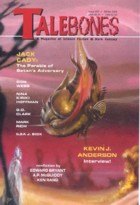"The Parable of Satan's Adversary" by Jack Cady
"Asleep In The Arms Of Ambience" by Mark Rich
"Time Bombs" by Nina Kiriki Hoffman
"Gory Taber Was Afraid" by Diana Sherman
"Mache" by Catherine MacLeod
"Dust" by Marsha J. Allard
"Beyond Antares" by Ilsa J. Bick
 Talebones is always hit or miss with me, and the Winter 2003 issue is an excellent example. Several of the stories really grabbed me, but others were not my cup of tea.
Talebones is always hit or miss with me, and the Winter 2003 issue is an excellent example. Several of the stories really grabbed me, but others were not my cup of tea.
Jack Cady's Satan is a pitiable figure, beset by rising coal prices, fiery union organizers and a sliding standard of sin. But what really irks is that humanity has stopped fearing him. Maxie, one of a misfit gang of retirees who become Satan's confidantes, puts it best: "I been handling the human race for 80 years… Nothin' Hell can show me is more'n a walk in the park."
"The Parable of Satan's Adversary" is funny and a little bit sad, and overall a satisfying diversion.
It's hard to know what to make of "Asleep in the Arms of Ambience" by Mark Rich. Touring Rich's fictional City of Ambience is like taking LSD while wandering through an exhibition of paintings from the Hudson River school. People appear and disappear at random, ghosts float about the premises possessing citizens, and everything is blanketed in the glowing light of evening and a gentle seaside mist.
The plot revolves around the disembodied specters of Jason Firth, Artist of Ambience, and Phillip Green, who might have been his killer, and Tandy Best, and reluctant resident of the city. Reality is fluid, and fighting a sneeze a dangerous activity.
I can't say I particularly liked this story, but if you're fond of psychedelia, you'll probably appreciate it.
All the action takes place in a men's restroom at a restaurant. Pete, the focal character, confronts a man wearing a pin that identifies him as a member of a violent student group. For Pete, it's about revenge for his sister's death. For the man, it's release. For the man's girlfriend, it may be the end of a life she's dreamed of.
Hoffman does an excellent job of precision character development: not a word is wasted, and every one contributes to a gripping tale.
Gordy Taber is not your typical twisted sociopathic murderer. His crimes are selfish, but not sadistic: he's simply practicing the aversion technique to overcome his fear of death. This much you can probably gather from Diana Sherman's title, "Gordy Taber was Afraid."
One day Gordy's past catches up with him when the ghost of a former victim convinces him to visit Hades. Why conquer just your fear of death, she suggests, when you might be able to conquer death itself? But the cure for death might well be worse than the disease.
I'm not a big fan of the genre, which at times seems to have the stylized formality of a kabuki play. This particular example also felt too long to me.
Alarice Rogan is an reclusive, independently wealthy papier mache artist with a broken heart in Catherine MacLeod's "Mache." Truvy Caswell is a college student with the perseverence to score an interview. Caswell's questions set Rogan on an introspective voyage through the past of her relationship with Joshua, her manager and husband.
Rogan is a really strong character, human and complex and just a little bit broken. Her life with Joshua does not end happily, but you'll be very happy you were brought along for the voyage.
"Dust" made me want to cry. Martha J. Allard gives us a peek at Peter Pan and Tinkerbell after the death of Wendy. It's not a happy life: Peter goes from town to town with Kensington's Carnival, trying to find a replacement for Wendy. Tink follows him, as she always has, drawn to him against her own best interests. Tink is losing her magic in dribs and drabs, keeping Peter from becoming the aged husk of a man he would otherwise be.
In the end, Peter has to decide if he can let Tink go. It's a beautiful if melancholy ending.
In 1988, Hank Bascomb's son died when a secret military mission through a wormhole dropped him at Antares right as the star went supernova. Being an ornery type, Hank decided to stick around for five-hundred years, until the light from that distant explosion finally reached Earth. No one, not even his iron-fisted nurse, can keep him from witnessing his son's final moments.
More machine than human, Hank sits on his porch waiting for the light to arrive, thinking about the past, and planning to die.
"Beyond Antares" by Ilsa J. Bick verges on being trite, but pulls back from the edge and never quite drops into the abyss of cliche. Hank is a likable character, mean in a good way, and deeply caring as well.
All in all a mixed bag of fiction that will probably appeal, at least in part, to most readers.
Jeremy Lyon is a freelance writer, tech industry cube farmer and the publisher of Futurismic, a site for people interested in the future and the effects of science and technology on the present.